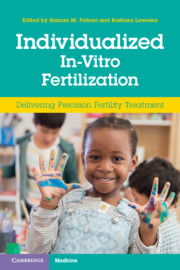Book contents
- Individualized In-Vitro Fertilization
- Individualized In-Vitro Fertilization
- Copyright page
- Contents
- Contributors
- Chapter 1 Individualized Ovarian Stimulation for Normal and High Responders
- Chapter 2 Individualized Ovarian Stimulation in Patients with Advanced Maternal Age and Premature Ovarian Aging
- Chapter 3 Individualized Oocyte Maturation
- Chapter 4 Individualized Luteal Phase Support
- Chapter 5 Individualized Management of Male Infertility
- Chapter 6 Individualized Fertilization Technique in the IVF Laboratory
- Chapter 7 Individualized Genetic Testing
- Chapter 8 Individualized Embryo Selection
- Chapter 9 Preparation for Optimal Endometrial Receptivity in Cryo Cycles
- Chapter 10 Individualized Immunological Testing in Recurrent Implantation Failure
- Chapter 11 Individualized Embryo Transfer
- Index
- Plate Section (PDF Only)
- References
Chapter 1 - Individualized Ovarian Stimulation for Normal and High Responders
Published online by Cambridge University Press: 12 February 2021
- Individualized In-Vitro Fertilization
- Individualized In-Vitro Fertilization
- Copyright page
- Contents
- Contributors
- Chapter 1 Individualized Ovarian Stimulation for Normal and High Responders
- Chapter 2 Individualized Ovarian Stimulation in Patients with Advanced Maternal Age and Premature Ovarian Aging
- Chapter 3 Individualized Oocyte Maturation
- Chapter 4 Individualized Luteal Phase Support
- Chapter 5 Individualized Management of Male Infertility
- Chapter 6 Individualized Fertilization Technique in the IVF Laboratory
- Chapter 7 Individualized Genetic Testing
- Chapter 8 Individualized Embryo Selection
- Chapter 9 Preparation for Optimal Endometrial Receptivity in Cryo Cycles
- Chapter 10 Individualized Immunological Testing in Recurrent Implantation Failure
- Chapter 11 Individualized Embryo Transfer
- Index
- Plate Section (PDF Only)
- References
Summary
Despite the notion that the first baby, Louise Brown, was born in 1978 following IVF performed in a natural menstrual cycle, ovarian stimulation became the golden standard of care in clinical IVF, since the number of oocytes retrieved is directly associated with pregnancy and life birth rates (, ). The aim should be to titrate the stimulation in such a way that the optimal number of follicles develops. Too few follicles (also referred to as low response) usually means poor IVF outcome, whereas too many developing follicles induce a risk for developing OHSS and possibly reduce the chance of success with increasing number of oocytes, if stimulation is not adjusted toward the end of the follicular phase (, ).
- Type
- Chapter
- Information
- Individualized In-Vitro FertilizationDelivering Precision Fertility Treatment, pp. 1 - 13Publisher: Cambridge University PressPrint publication year: 2021

